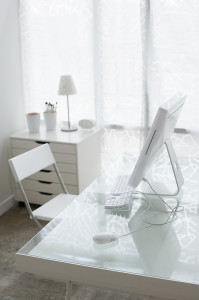Systems to Have in Place by Meggin McIntosh, PhD
 Systems are a key element to productivity. While you may not use every system every day, having systems that are available to you the moment you need them, helps you limit the amount of time you worry about a task so you can get right down to completing it.
Systems are a key element to productivity. While you may not use every system every day, having systems that are available to you the moment you need them, helps you limit the amount of time you worry about a task so you can get right down to completing it.
-
Your desk is a place to work. If you work in a home office this is especially important. If you fold clothes on your work desk, or stack your personal mail, or hold conversations with your family, or any of a million other non-work concepts at your desk, you will have to take a few minutes to clear your desk of these concerns before you can get to work. These minutes add up.
-
Organize your desk using the ABCD concept. Remember that your workspace is like a target with the “A” space as a bull’s eye. Look around your desk periodically to ensure that you’re only keeping key items in the “A” space. Are you leaving your desk regularly for necessary materials? Put them in your “A” space. Rearrange regularly to accommodate your changing work needs. Refer to an earlier Top Ten Productivity Tips for a refresher on the ABCD concept.
-
Have an inbox (for paper and physical objects). Have a goal to clean this box out every day and AT LEAST once a week.
-
Have an inbox (electronic). Learn how to use the “folders” feature for your electronic inbox.
-
Have a ready supply of next action sheets. Whenever you’re talking to someone on the phone or in person, have a next action sheet ready to take notes. For a sample, click on the “downloads” button at Top Ten Productivity Tips.
-
Employ a tickler file for the month. This is a 1-31 file that allows you to place tasks or needed items (like an agenda for a meeting or the tickets to a show) daily for a month.
-
Use a tickler file for the months of the year. This is a January – December system that allows you to put reminders for items in upcoming months (or cards that you have purchased for events, etc.).
-
File with Paper Tiger Software. I’d be lost without it. This is a numeric system for filing and will change your life if you use it. Seriously.
- Write down anything and everything that comes into your head that you need or want to do. Immediately drop that note into your physical inbox to process later. Your brain is a brilliant at thinking and problem solving and creating…but dreadful at remembering. Get ideas, tasks, projects out of your head and into a bin where you can process it.
-
Get a good planner that you’ll really use. Splurge a little and buy the one you really want. I’ve tried, and have never been successful, with smartphones, so now I allow myself to buy a beautiful new planner every year with just the pages I like (consider Franklin Planner, Day-Timer, Circa, or whatever works for you). I take it everywhere and use it every day. Get the planner system (paper or electronic or some combination) that works for you. Take a class and learn how to use it productively.
Just put one of these systems into place (that you currently don’t employ) and see what kind of difference it makes for you.
 And if you’d like more ideas to help you find balance in your space you will want to access the Get a Plan! Guide® to De-clutter & De-stress: A Dozen Ways to Decrease Your Clutter and Decrease Your Stress. This Get a Plan! Guide® will help you learn a dozen specific ways to start dealing deliberately with your clutter – and then experiencing a reduction in your stress.
And if you’d like more ideas to help you find balance in your space you will want to access the Get a Plan! Guide® to De-clutter & De-stress: A Dozen Ways to Decrease Your Clutter and Decrease Your Stress. This Get a Plan! Guide® will help you learn a dozen specific ways to start dealing deliberately with your clutter – and then experiencing a reduction in your stress.




